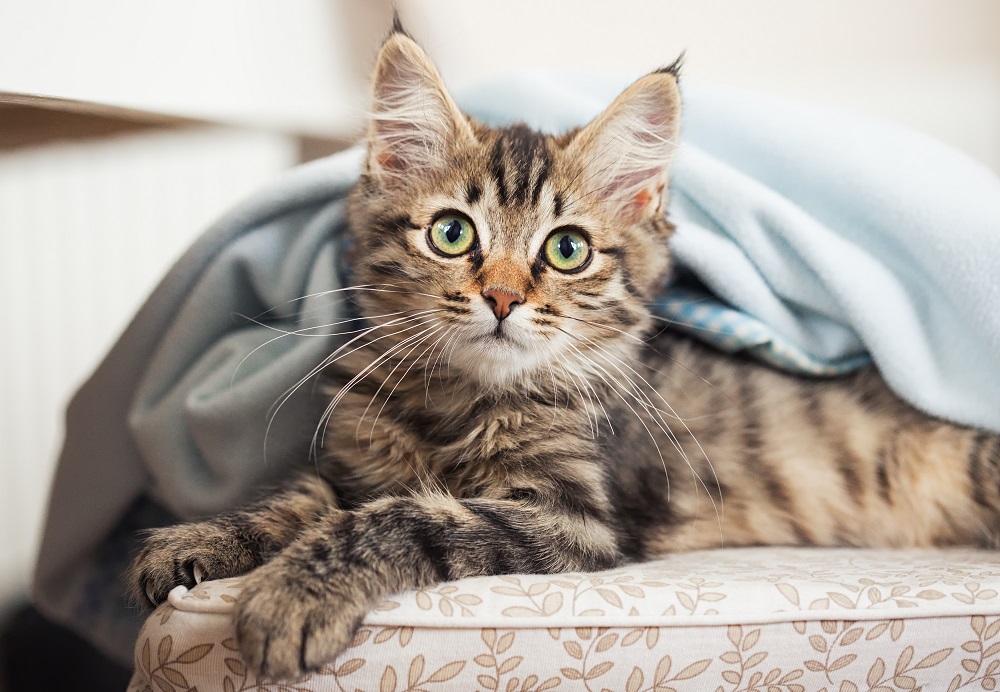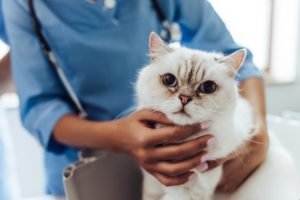
Whether green, blue, or amber, your cat’s eyes are one of their most important features—and not only for their beauty. Your cat relies on their sight to guide them through the world, help them avoid danger, and find their way to your hand for a loving rub. An eye problem can interfere with your cat’s daily life, in addition to causing discomfort, and possibly vision impairment. If your family veterinarian diagnoses an eye condition in your cat that requires advanced diagnostics or specialty care, Upstate Vet’s ophthalmology department can partner with them to ensure the best outcome for your feline friend. Our board-certified veterinary ophthalmologists treat a variety of eye ailments in cats, including these common conditions.
Herpesvirus is a common cause of upper respiratory infection in cats and kittens. After an initial phase of sneezing, nasal discharge, and lethargy, the virus can remain dormant in an infected cat’s body, with periodic recurrence of clinical signs, particularly during times of stress or illness. Affected cats experience corneal ulcers, in addition to upper respiratory signs, and recurring ulcers can cause scarring and permanent damage to the corneal and conjunctival tissues.
Feline herpesvirus sometimes requires life-long management. Since repeated ocular inflammation and ulcers can lead to permanent corneal damage and vision loss, cats with ocular herpes should be managed by a veterinary ophthalmologist to preserve their vision. Treatment involves medications to enhance immune function, and shorten the duration and severity of flare-ups.
A corneal ulcer is an abrasion, scratch, or deeper wound on the eye surface that often results from ocular trauma, such as a scratch from another animal, or secondary to feline herpesvirus. These painful ulcers typically cause redness, squinting, tearing, and discharge, and sometimes a cloudy-looking cornea.
A sequestrum is a common sequelae of a feline corneal ulcer, where the damaged corneal tissue dies, and turns black or brown. The eye recognizes the sequestrum as a foreign body, and initiates an inflammatory reaction, causing cloudiness and vascularization in the surrounding cornea, which is typically void of blood vessels. A sequestrum weakens the cornea, and places the eye in danger of infection or rupture, which makes management of this condition by a veterinary ophthalmologist critical. Some sequestrums can be medically managed, but many require surgical treatment, especially if the lesion causes pain or discomfort.

Uveitis is inflammation of the uvea, or the middle eyeball layer, which contains the iris, ciliary body, and choroid. Uveitis is a painful condition that can cause a range of ocular signs, but pain-related signs, such as tearing, light sensitivity, squinting, and third eyelid elevation, are most common. Intraocular inflammation can cause the retinal vessels to leak red blood cells, white blood cells, and protein into the eye, which may discolor the intraocular fluid, or settle to the bottom of the eye.
Melanomas, which are cancerous tumors that arise from melanocytes (i.e., pigment-producing cells), are the most common ocular tumors of cats. They frequently develop on the iris (i.e., colored part of the eye), and appear as flat black areas. Initial color changes may be benign, but may then transform to a cancerous melanoma, so any color change of your cat’s iris should be evaluated by your family veterinarian, or a veterinary ophthalmologist.
Melanomas can originate in the eye, or in other body locations and spread to the eye. If an ocular melanoma is detected, testing for the presence of other masses is often necessary. Melanomas that originate in the eye may metastasize (i.e., spread) to other body areas, so careful monitoring is critical, and eye removal (i.e., enucleation) may be necessary.
Hypertension, or high blood pressure, is common in older cats, and often develops secondary to systemic diseases, such as kidney failure or hyperthyroidism. High blood pressure can cause the blood vessels in the back of the eye to leak fluid, causing the retinas to detach, and the cat to become acutely blind. With prompt treatment to decrease blood pressure, the retinas may reattach, and more than half of cats who are treated early regain some vision. Management by a veterinary ophthalmologist is critical during this stage, and after, for the best chance of vision returning.
Frequent blood pressure monitoring is extremely important for any cat who is diagnosed with kidney failure, hyperthyroidism, or hypertension, to prevent retinopathy, and possible blindness.
To learn more about the 'Top 5 Eye Conditions in Dogs & Cats', download our brochure.
Your cat’s eyesight is irreplaceable, and we’ll do everything we can to protect their vision. If you believe your cat has one of these eye issues, or another ocular problem, see your family veterinarian, or contact our ophthalmology department.